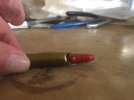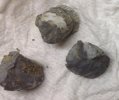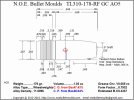Dimner
Named Man
Okay, quick sanity check before I blend a bunch of small batches of alloy that I have procured over the years. My goal is to make a multi-use alloy that I can use without alteration for 90% of my casting. Then have some ingredients on hand as 'pot sweeteners' if I need to make a pot full of an alloy for special needs.
I have plenty of linotype, 99.5% pure tin, and pewter on hand, so I'm not really concerned about wasting tin. If it helps the alloy, it helps me.
95% of my casting is for Rifle and I powder coat everything I can. The only time I do not powder coat is when the PC works against me. Most casting is for 30cal with some PC/heat treated 22cal thrown in. Unless I'm working on a special project, for the 30 cals, I do not go over 2100. For the 22, it's for an AR15 pushed to 2400fps.
So gut check time:
multi-use alloy: 96pb/2.5sb/1.5sn - would it be any benefit to goto 95/2.5/2.5?
I'll keep on hand about 300lbs of blended CWW that I'm getting tested.
As well as 450 lbs of indoor range scrap that will be tested.
To get my multi-use alloy, I will start with my range lead and blend in various 50-75lb batches of alloys that I have been sitting on unused. Lyman #2, some 'HardCast' Alloy (95.2/4.7/0.1), and SWW. Then using my alloy calculator adding tin, pewter, and linotype until I reach my desired composition.
So, with all that said...... What part of my plan makes you cringe? Makes you say: "oh god, don't do THAT!" What am I missing and what should be changed?
I have plenty of linotype, 99.5% pure tin, and pewter on hand, so I'm not really concerned about wasting tin. If it helps the alloy, it helps me.
95% of my casting is for Rifle and I powder coat everything I can. The only time I do not powder coat is when the PC works against me. Most casting is for 30cal with some PC/heat treated 22cal thrown in. Unless I'm working on a special project, for the 30 cals, I do not go over 2100. For the 22, it's for an AR15 pushed to 2400fps.
So gut check time:
multi-use alloy: 96pb/2.5sb/1.5sn - would it be any benefit to goto 95/2.5/2.5?
I'll keep on hand about 300lbs of blended CWW that I'm getting tested.
As well as 450 lbs of indoor range scrap that will be tested.
To get my multi-use alloy, I will start with my range lead and blend in various 50-75lb batches of alloys that I have been sitting on unused. Lyman #2, some 'HardCast' Alloy (95.2/4.7/0.1), and SWW. Then using my alloy calculator adding tin, pewter, and linotype until I reach my desired composition.
So, with all that said...... What part of my plan makes you cringe? Makes you say: "oh god, don't do THAT!" What am I missing and what should be changed?



